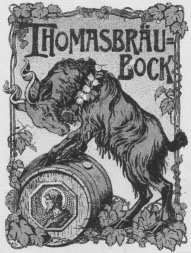Bock Beer, a strong beer with an original gravity above 16 degrees Plato and a typical alcohol content beyond 6.5% ABV. The style originated in the lower-Saxonian town of Einbeck, Germany and has many regional and commercial variations. Some of these claim to have historical roots, and others are simply experimenting with the effects of certain ingredients and/or certain yeast strains on a wort of high gravity. While most bock beers are bottom fermented lagers, there is a broad range of top fermenting beers that also fall into the category, with weizenbock being the most prominent among them. Many strong ales of British, Belgian, or American origin are “bock beers” by the legal standards that have been established in many European countries for proper taxation, even if they are considered nothing of the sort in their home countries.

Poster stamp, c. 1875, advertising Thomasbräu Bock, produced by Paulaner, one of the big six Munich breweries. pike microbrewery museum, seattle, wa
It is generally assumed that the first commercial bock was brewed in the German town of Einbeck, halfway between Hannover and Kassel. Einbeck had won fame for brewing and exporting a very tasty strong beer in the middle ages. In 1368 Einbeck joined the Hanseatic League, which helped find customers for the beer from Einbeck in Scandinavia, Russia, Britain, and Flanders. These were markets that were already acquainted with strong beers from other Hansa member cities like Rostock that had joined the league about a century earlier. The oldest written record mentioning beer from Einbeck is a receipt for two casks of “Einbecker” sold to the town of Celle on April 28, 1378. A key factor for the success of Einbeck’s product was a unique system of quality control that had been established by the city council. Dozens of burghers were entitled to malt their own grains (barley and wheat, which accounted for one third of the grain bill) and make beer in their own cellar, but none of them was allowed to possess his own brewhouse. The brewing equipment was owned by the city and the city council employed professional brewers who would take the brew kettle to the homes of those burghers who wanted to brew. The brewmaster, being a civil servant to the city, had to check the malt, oversee the actual brewing process, and later certify the finished product before it could be sold or exported.
The streets of Einbeck’s historical town center are still lined with colorful timber-framed buildings from the 15th and 16th century that have extraordinarily large gateways. These had to be wide enough to bring in the brew kettle when it was moved from one town house to the next in the row. The procedure made sure that all beer brewed in Einbeck followed the same recipe and met the same quality standards regardless of which household had brewed it.
This early form of standardizing a product came along with a set of marketing ideas that seem to come right out of a textbook for modern branding although they have been applied half a millennium ago. The beer from Einbeck was tested at one of the leading laboratories of its time at the medical faculty of the university of Salerno where it was described as “vinum bonum” (“good wine”). In 1521 when the church-reformer Martin Luther, one of the most prominent men of his time, had to defend his program at the Diet (General Assembly) in Worms he brought along a jug filled with beer from Einbeck that he drank in public praising it as the “best drink one can know.” And most of all, Einbeck did a good job in branding its product as “Ainpöckisch Pier,” a term that was soon shortened to “Oanpock” by Bavarian consumers and later “a bock bier,” hence the name.
Shipments of the strong bock beer were growing. In 1578 the town of Munich spent 562 guilder on bock beer imported from Einbeck. It was time to copy its success. In 1617 Elias Pichler, a master brewer from Einbeck, was hired for the Hofbräuhaus in Munich to brew a Bavarian version of “Oanpock,” which became extremely popular especially in lent periods when strong drinks (“liquid bread”) had to replace at least some part of the food in the diet of a pious Catholic. This is why to this day many bock beers are labeled “Weihnachtsbock” or “Osterbock” for Christmas and Easter, respectively. Contrary to common belief these beers are not meant to celebrate the holidays but to be consumed in the weeks preceding them. For lent in spring an even stronger version of bock beer, “doppelbock,” is brewed every year in many Bavarian breweries, some breweries also brew a “Maibock” to be consumed in May.
Most of the bock beers are golden to amber in color, but some can also be reddish or even black. A relevant commercial example for this style is the “Zipfer Stefanibock,” the best-selling bock beer in Austria, and of course the “Ur-Bock” from Einbecker Brauhaus, the only surviving brewery in Einbeck city. The small Plank brewery in Franconia brews an award-winning weizenbock and the “Masuren-Dunkel” from Browar Kormoran in Poland is an example of a typical dark bock. Many—but not all—bock beers tend to be full-bodied to slightly sweet and malty with a floral or fruity note. They are generally not hop-driven beers, and bitterness is kept to a moderate level. It should be noted that bock beers tend to age very well, with some able to cellar for many decades.
